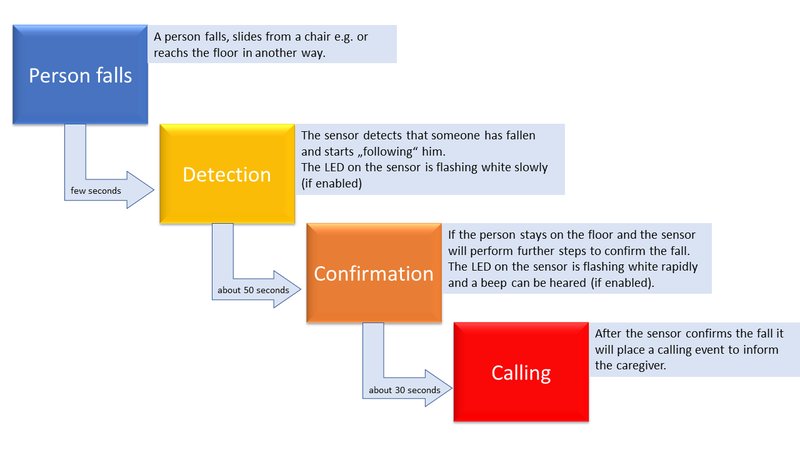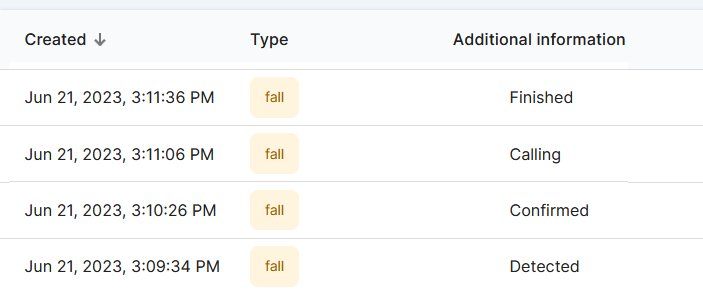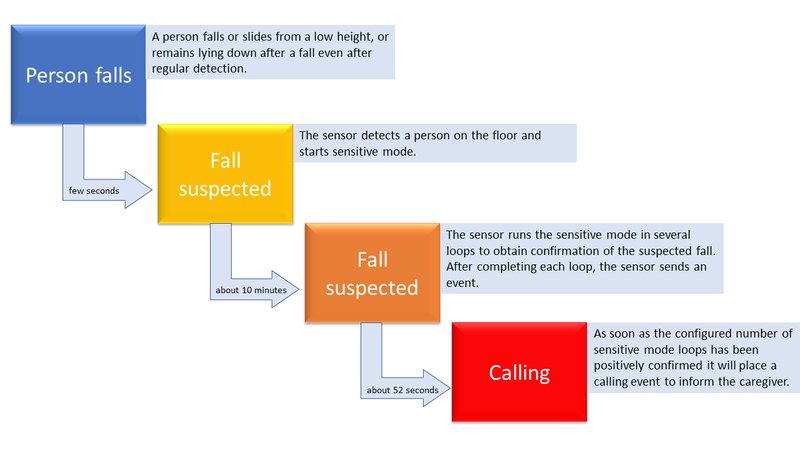5. Detection phases
Depending on the firmware version installed on the sensor, it is able to detect falls using different methods and functions.
Fall detection
Function available in all firmware versions of the sensor.
The sensor has to complete several phases of fall detection to be sure a fall has take place and inform the caregiver. Each phase sends a corresponding event. There are three phases and five events.
Phases
After a person goes down to the floor it only takes few seconds until the sensor starts the detection. The LED of the sensor is flashing slowly white colored.
The detection is completed after round about 50 seconds and the sensor starts the confirmation. In this phase the LED of the sensor is flashing rapidly white colored and a beep can be heard.
After the confirmation is completed it takes circa 30 seconds until the sensors send the calling. The LED stops flashing and the beep stops too.
At the end of this process the sensor sends a finish.
As soon as the person stands up or another person enters the room the fall detection stops with an exit event.
The fall detection will take 90 seconds normally. In some cases the maximum duration to detect a fall is 150 seconds.
Flowchart

Events

Fall test
The following procedure is possible to carry out a fall test:
- enter the detection area
- Walk around for 1-2 minutes
- go down slowly
- lay flat on your back
- Wait for the detection phases to pass
Sensitivity mode
Function available from sensor firmware versions 38 and higher. This must be activated in order to use it.
The sensor runs through several loops of the sensitivity mode in order to reliably detect and report a fall. Depending on the loop reached, a corresponding event is sent by the sensor. There are 2 phases and 4 events.
Phases
After a person has fallen from a low height or is still lying on the ground after a fall, it takes a few seconds for the sensor to detect a suspected fall.
The recognition is completed after approx. 50 seconds, but is repeated in several loops. In the standard configuration, 4 of 5 loops of the sensitive mode must reach a so-called “confidence level” of over 0.78 for the fall to be reported as such.
As soon as the loops with a corresponding “confidence level” have been run through, it takes approx. 50 seconds until the calling is made.
After sending the emergency call, the finished of the sensitivity mode is communicated and the sensitive mode ended.
If the person who fell on the ground gets up or another person enters the room, each phase can be fall_exit at any time.
The whole process usually takes about 300 seconds (5 minutes). The maximum duration can take up to 600 seconds (10 minutes).
Flowchart

Events

Test of the sensitive mode
The following procedure is possible to carry out a test of the sensitive mode:
- carry out a fall test as described above
- however, after being detected and reported, continue to lie flat on the ground for 5 to 6 minutes
- Wait for the sensitive mode loops to run through
Alternatively:
- enter the detection area
- Walk around for 1-2 minutes
- sit on a low chair for 1-2 minutes
- slide from the chair to the floor
- Remain flat on the floor for 5 to 6 minutes
- Wait for the sensitive mode loops to run through